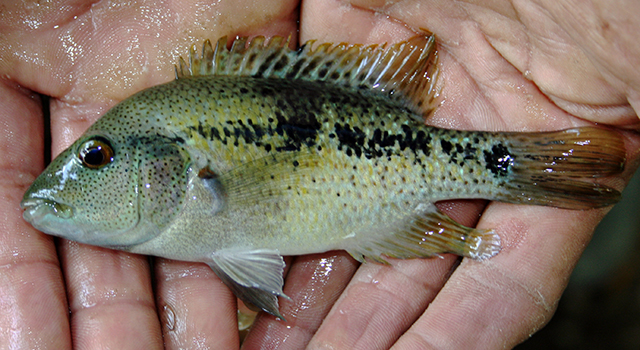| Cichlidae (Cichlids), subfamily: Cichlasomatinae |
| 11.23 cm SL (male/unsexed) |
|
benthopelagic; freshwater; pH range: 7.8 - 8.3 |
| Central America: main stem and tributaries of the Rio Gallinas, including Rio Tamasopo, Ojo Frío, and Agua Buena, upriver from the Tamul cascade in Mexico. |
|
Dorsal spines (total): 16-17; Dorsal soft rays (total): 10-11; Anal spines: 5-5; Anal soft rays: 8-9. This species can be diagnosed by having the following characters: predorsal contour gradual and acute, not concave before eye; dorsal and ventral contours straight to moderately convex, sloping slowly; intersection with caudal peduncle inconspicuous; and mouth slightly angled downward; ground color khaki when alive; snout, head, and opercles heavily dotted with tiny speckles, extending posteriorly onto nuchal area and base of dorsal fin; eye diameter small (mean 23%, SD 1%), snout long (mean 39%, SD 2%); cheeks shallow (mean 29%, SD 2%) (all in HL); lower pharyngeal plate stout and much broader than long; horns short with lightly pigmented stout molars, 2 central rows of 6-7 molars flank the midline, posterior-most 3 big and stout; and peritoneum uniformly very dark (Ref. 94458). |
| Inhabits clear water over a rocky substrate with hardness above 100° dH and pH between 7.8 and 8.3. Sampled together with Herichthys tamasopoensis, H. steindachneri, Xiphophorus montezumae, and Gambusia panuco, among other species of fishes. Based on three specimens examined, stomach contents include detritus (5%), filamentous algae (20%), snails (70%), and unidentified materials (5%) (Ref. 94458). |
|
Not Evaluated (N.E.) Ref. (130435)
|
| harmless |
Source and more info: www.fishbase.org. For personal, classroom, and other internal use only. Not for publication.

